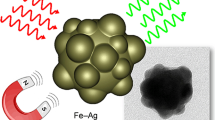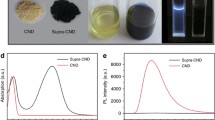Abstract
A novel single-step, laser-induced and solution-based process is presented for synthesizing complex hybrid metal/carbon nanostructures. The process relies on simply illuminating the interface between a substrate and a liquid solution of the supramolecular complex [Au13Ag12(C2Ph)20(PPh2(C6H4)3PPh2)3][PF6]5 (hereinafter abbreviated as SMC) with an unfocussed He–Cd laser having a wavelength of 325 nm and an intensity of I = 0.5 W/cm2. The process results in hybrid nanostructures of well-controlled morphology: nanoparticles (NP) and 2D flakes, which may also grow jointly to form 3D morphologically complex multipetal ‘flower-like’ structures. At the atomic scale, the obtained metamaterials are complex in composition and structure, i.e., they contain bimetallic Au–Ag nanoclusters of diameter 3–5 nm incorporated inside a carbonaceous matrix. This matrix can be amorphous or crystalline, and the details of the compositional outcome can be controlled and steered by the laser deposition parameters. Au–Ag nanoclusters show plasmonic behavior including the enhancement of electromagnetic fields of visible light. This leads to the enhancement of Raman scattering by the Au–Ag nanoparticle ensemble within the carbonaceous matrix. This enables a 3D architecture for stimulating surface-enhanced Raman scattering (SERS).





Similar content being viewed by others

References
Povolotskaya AV, Povolotskiy AV, Manshina AA (2015) Hybrid nanostructures: synthesis, morphology and functional properties. Russ Chem Rev 84:579. https://doi.org/10.1070/RCR4487
Pan X, Ji F, Kuang L et al (2016) Synergetic effect of three-dimensional Co3O4@Co(OH)2 hybrid nanostructure for electrochemical energy storage. Electrochim Acta 215:298–304. https://doi.org/10.1016/j.electacta.2016.08.102
Xiong P, Zhu J, Zhang L, Wang X (2016) Recent advances in graphene-based hybrid nanostructures for electrochemical energy storage. Nanoscale Horiz 1:340–374. https://doi.org/10.1039/C5NH00134J
Lim B, Wang J, Camargo PHC et al (2009) Twin-induced growth of palladium–platinum alloy nanocrystals. Angew Chemie Int Ed 48:6304–6308. https://doi.org/10.1002/anie.200902235
Lim B, Jiang M, Camargo PHC, et al (2009) Pd–Pt bimetallic nanodendrites with high activity for oxygen reduction. Science 324(80):1302–1305. https://doi.org/10.1126/science.1170377
Pang M, Hu J, Zeng HC (2010) Synthesis, morphological control, and antibacterial properties of hollow/solid Ag 2 S/Ag heterodimers. J Am Chem Soc 132:10771–10785. https://doi.org/10.1021/ja102105q
Huang P, Pandoli O, Wang X et al (2012) Chiral guanosine 5′-monophosphate-capped gold nanoflowers: controllable synthesis, characterization, surface-enhanced Raman scattering activity, cellular imaging and photothermal therapy. Nano Res 5:630–639. https://doi.org/10.1007/s12274-012-0248-8
Zeng J, Xia Y (2012) Hybrid nanomaterials. Not just a pretty flower. Nat Nanotechnol 7:415–416. https://doi.org/10.1038/nnano.2012.105
Xia K, Zhan H, Gu Y (2017) Graphene and carbon nanotube hybrid structure: a review. Procedia IUTAM 21:94–101. https://doi.org/10.1016/j.piutam.2017.03.042
Argyo C, Weiss V, Bräuchle C, Bein T (2014) Multifunctional mesoporous silica nanoparticles as a universal platform for drug delivery. Chem Mater 26:435–451
Randeniya LK (2013) Alloy hybrid carbon nanotube yarn for multifunctionality. In: Schulz MJ, Shanov VN, Yin Z (eds) Nanotube superfiber materials changing engineering design. William Andrew Publishing, New York, pp 137–165
Aramesh M, Fox K, Lau DWM et al (2014) Multifunctional three-dimensional nanodiamond-nanoporous alumina nanoarchitectures. Carbon N Y 75:452–464. https://doi.org/10.1016/j.carbon.2014.04.025
Soldano C (2015) Hybrid metal-based carbon nanotubes: novel platform for multifunctional applications. Prog Mater Sci 69:183–212. https://doi.org/10.1016/j.pmatsci.2014.11.001
Benelmekki M (2015) Designing hybrid nanoparticles. Morgan and Claypool Publishers, San Rafael, p 68
Kumar NA, Dar MA, Gul R, Baek JB (2015) Graphene and molybdenum disulfide hybrids: synthesis and applications. Mater Today 18:286–298. https://doi.org/10.1016/j.mattod.2015.01.016
Li Q, Yao K, Zhang G et al (2015) Controllable synthesis of 3D hollow-carbon-spheres/graphene-flake hybrid nanostructures from polymer nanocomposite by self-assembly and feasibility for lithium–ion batteries. Part Part Syst Charact 32:874–879. https://doi.org/10.1002/ppsc.201500037
Madhuvilakku R, Alagar S, Mariappan R, Piraman S (2017) Green one-pot synthesis of flowers-like Fe 3 O 4 /rGO hybrid nanocomposites for effective electrochemical detection of riboflavin and low-cost supercapacitor applications. Sens Actuators B Chem 253:879–892. https://doi.org/10.1016/j.snb.2017.06.126
Lee T, Min SH, Gu M et al (2015) Layer-by-layer assembly for graphene-based multilayer nanocomposites: synthesis and applications. Chem Mater 27:3785–3796. https://doi.org/10.1021/acs.chemmater.5b00491
Zhu C, Guo S, Zhai Y, Dong S (2010) Layer-by-layer self-assembly for constructing a graphene/platinum nanoparticle three-dimensional hybrid nanostructure using ionic liquid as a linker. Langmuir 26:7614–7618. https://doi.org/10.1021/la904201j
Chen Y, Zeng D, Zhang K et al (2014) Au–ZnO hybrid nanoflowers, nanomultipods and nanopyramids: one-pot reaction synthesis and photocatalytic properties. Nanoscale 6:874–881. https://doi.org/10.1039/c3nr04558g
Manshina AA, Grachova EV, Povolotskiy AV et al (2015) Laser-induced transformation of supramolecular complexes: approach to controlled formation of hybrid multi-yolk-shell Au–Ag@ aC: H nanostructures. Sci Rep 5:12027. https://doi.org/10.1038/srep12027
Bashouti MY, Manshina A, Povolotckaia A et al (2015) Direct laser writing of µ-chips based on hybrid C–Au–Ag nanoparticles for express analysis of hazardous and biological substances. Lab Chip 15(7):1742–1747. https://doi.org/10.1039/C4LC01376J
Povolotskiy A, Povolotckaia A, Petrov Y et al (2013) Laser-induced synthesis of metallic silver–gold nanoparticles encapsulated in carbon nanospheres for surface-enhanced Raman spectroscopy and toxins detection. Appl Phys Lett 103:113102. https://doi.org/10.1063/1.4820841
Koshevoy IO, Karttunen AJ, Tunik SP et al (2009) Synthesis, characterization, photophysical, and theoretical studies of supramolecular gold(I)−silver(I) Alkynyl-Phosphine complexes. Organometallics 28:1369–1376. https://doi.org/10.1021/om8010036
Pouchou J-LPF (1991) Quantitative analysis of homogeneous or stratified microvolumes applying the model “PAP”. In: Heinrich KFJ, Newbury DE (eds) Electrone probe quantitation. Springer, Boston, pp 31–75
Schmitt SW, Schechtel F, Amkreutz D et al (2012) Nanowire arrays in multicrystalline silicon thin films on glass: a promising material for research and applications in nanotechnology. Nano Lett 12:4050–4054. https://doi.org/10.1021/nl301419q
Boeck T, Ringleb F, Bansen R (2017) Growth of crystalline semiconductor structures on amorphous substrates for photovoltaic applications. Cryst Res Technol 52:1600239. https://doi.org/10.1002/crat.201600239
Kim K, Kim KL, Lee SJ (2005) Surface enrichment of Ag atoms in Au/Ag alloy nanoparticles revealed by surface enhanced Raman scattering spectroscopy. Chem Phys Lett 403:77–82. https://doi.org/10.1016/j.cplett.2004.12.025
Tuinstra F, Koenig JL (1970) Raman spectrum of graphite. J Chem Phys 53:1126–1130. https://doi.org/10.1063/1.1674108
Endo M, Pimenta MA (1999) Origin of dispersive effects of the raman d band in carbon materials. Phys Rev B Condens Matter Mater Phys 59:R6585. https://doi.org/10.1103/PhysRevB.59.R6585
Bokobza L, Bruneel JL, Couzi M (2015) Raman spectra of carbon-based materials (from graphite to carbon black) and of some silicone composites. C 1:77–94. https://doi.org/10.3390/c1010077
Ferrari AC (2007) Raman spectroscopy of graphene and graphite: disorder, electron–phonon coupling, doping and nonadiabatic effects. Solid State Commun 143:47–57. https://doi.org/10.1016/j.ssc.2007.03.052
Schlicht S, Kireev A, Vasileva A et al (2017) A model electrode of well-defined geometry prepared by direct laser-induced decoration of nanoporous templates with Au–Ag@C nanoparticles. Nanotechnology 28:65405. https://doi.org/10.1088/1361-6528/aa536a
Pankin D, Kolesnikov I, Vasileva A et al (2018) Raman fingerprints for unambiguous identification of organotin compounds. Spectrochim Acta A Mol Biomol Spectrosc 204:158–163. https://doi.org/10.1016/j.saa.2018.06.044
Acknowledgements
The reported study was supported by RFBR project #17-03-01284, St. Petersburg university grant 12.40.1342.2017 and by the German Research Foundation (DFG) within the research projects ‘Dynamics and Interactions of Semiconductor Nanowires for Optoelectronics’ (FOR 1616) and ‘Hybrid Inorganic/Organic Systems for Opto-Electronics’ (HIOS, SFB 951). Raman and UV/Vis absorption spectra were measured at Center for Optical and Laser Materials Research and Centre for Geo-Environmental Research and Modelling (GEOMODEL), TEM and SEM analysis was carried out at the Interdisciplinary Resource Center for Nanotechnology, XRD analysis was carried out at Centre for X-ray Diffraction Studies, MBT solutions were prepared at Centre for Molecular and Cell Technologies, St. Petersburg State University. The authors are grateful to I. Koshevoy and S. Tunik for allocation of SMC, I. Kasatkin for XRD analysis.
Author information
Authors and Affiliations
Corresponding author
Additional information
Publisher's Note
Springer Nature remains neutral with regard to jurisdictional claims in published maps and institutional affiliations.
Electronic supplementary material
Below is the link to the electronic supplementary material.
Rights and permissions
About this article
Cite this article
Povolotckaia, A., Pankin, D., Petrov, Y. et al. Plasmonic carbon nanohybrids from laser-induced deposition: controlled synthesis and SERS properties. J Mater Sci 54, 8177–8186 (2019). https://doi.org/10.1007/s10853-019-03478-9
Received:
Accepted:
Published:
Issue Date:
DOI: https://doi.org/10.1007/s10853-019-03478-9



